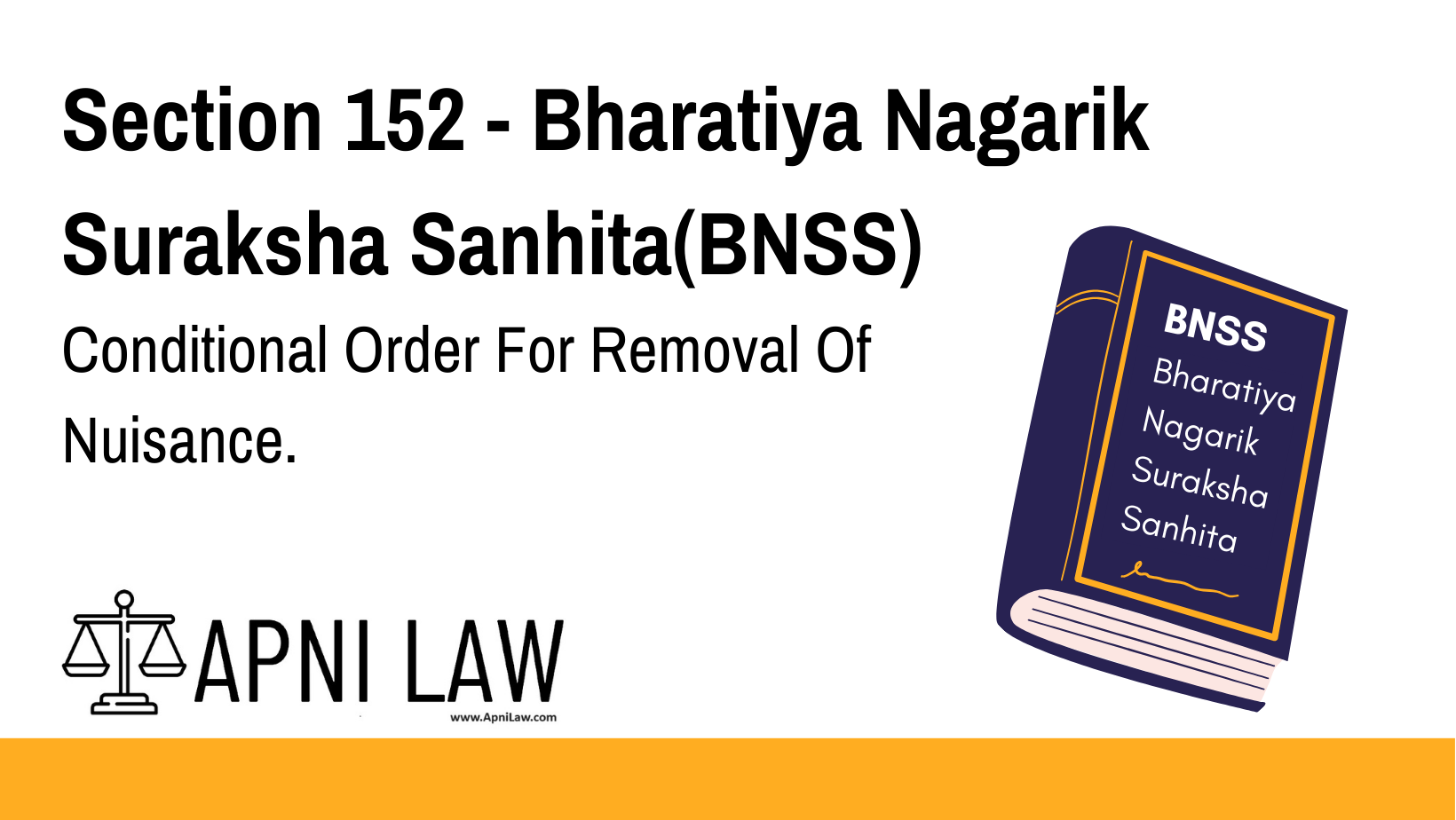Code: Section 152 BNSS
Conditional Order for Removal of Nuisance
(1) Whenever a District Magistrate or a Sub-divisional Magistrate or any other Executive Magistrate specially empowered in this behalf by the State Government, on receiving the report of a police officer or other information and on taking such evidence (if any) as he thinks fit, considers—
(a) that any unlawful obstruction or nuisance should be removed from any public place or from any way, river or channel which is or may be lawfully used by the public; or
(b) that the conduct of any trade or occupation, or the keeping of any goods or merchandise, is injurious to the health or physical comfort of the community, and that in consequence such trade or occupation should be prohibited or regulated or such goods or merchandise should be removed or the keeping thereof regulated; or
(c) that the construction of any building, or, the disposal of any substance, as is likely to occasion conflagration or explosion, should be prevented or stopped; or
(d) that any building, tent or structure, or any tree is in such a condition that it is likely to fall and thereby cause injury to persons living or carrying on business in the neighbourhood or passing by, and that in consequence the removal, repair or support of such building, tent or structure, or the removal or support of such tree, is necessary; or
(e) that any tank, well or excavation adjacent to any such way or public place should be fenced in such manner as to prevent danger arising to the public; or
(f) that any dangerous animal should be destroyed, confined or otherwise disposed of,
such Magistrate may make a conditional order requiring the person causing such obstruction or nuisance, or carrying on such trade or occupation, or keeping any such goods or merchandise, or owning, possessing or controlling such building, tent, structure, substance, tank, well or excavation, or owning or possessing such animal or tree, within a time to be fixed in the order—
(i) to remove such obstruction or nuisance; or
(ii) to desist from carrying on, or to remove or regulate in such manner as may be directed, such trade or occupation, or to remove such goods or merchandise, or to regulate the keeping thereof in such manner as may be directed; or
(iii) to prevent or stop the construction of such building, or to alter the disposal of such substance; or
(iv) to remove, repair or support such building, tent or structure, or to remove or support such trees; or
(v) to fence such tank, well or excavation; or
(vi) to destroy, confine or dispose of such dangerous animal in the manner provided in the said order, or, if he objects so to do, to appear before himself or some other Executive Magistrate subordinate to him at a time and place to be fixed by the order, and show cause, in the manner hereinafter provided, why the order should not be made absolute.
(2) No order duly made by a Magistrate under this section shall be called in question in any Civil Court.
Explanation.—A “public place” includes also property belonging to the State, camping grounds and grounds left unoccupied for sanitary or recreative purposes.
Explanation of Section 152 BNSS
Section 152 of the Bharatiya Nagarik Suraksha Sanhita (BNSS) grants Executive Magistrates the authority to issue conditional orders to remove obstructions, nuisances, or hazards that pose risks to public safety, health, or convenience.
This section ensures swift action against nuisances, dangerous buildings, hazardous occupations, and unsafe structures. If a person disagrees with the order, they must appear before the Magistrate to justify why the order should not be enforced.
Illustration
Example 1: Unlawful Obstruction in a Public Place
A shopkeeper illegally extends his shop onto the sidewalk, blocking pedestrian movement. The Magistrate, upon receiving a complaint, issues a conditional order under Section 152, directing the shopkeeper to remove the obstruction or appear in court.
Example 2: Dangerous Building
A building in a busy market area shows signs of structural weakness and risks collapsing. The Magistrate orders its repair or demolition under Section 152, ensuring public safety.
Example 3: Dangerous Animal
A pet owner keeps a highly aggressive dog that has attacked people. The Magistrate orders its confinement or disposal, preventing further harm.
Common Questions and Answers on Section 152 BNSS
1. Who can issue an order under Section 152 BNSS?
- Answer: A District Magistrate, Sub-divisional Magistrate, or an Executive Magistrate empowered by the State Government.
2. What actions can the Magistrate order under this section?
- Answer: The Magistrate can order the removal of nuisances, unlawful obstructions, dangerous buildings, hazardous occupations, unsafe trees, wells, or dangerous animals.
3. Can a person challenge the order in a Civil Court?
- Answer: No, per Subsection (2), orders issued under Section 152 BNSS cannot be questioned in a Civil Court.
4. What if the person disagrees with the order?
- Answer: The person must appear before the Magistrate and provide reasons why the order should not be made absolute.
5. What happens if the person does not comply?
- Answer: If the person fails to act or justify non-compliance, the order is made absolute, and enforcement action follows.
Conclusion
Section 152 BNSS empowers Executive Magistrates to address public nuisances and safety threats swiftly. It plays a vital role in preventing hazards, public inconvenience, and unlawful obstructions, ensuring smooth governance and public welfare.
For more insights on BNSS sections, visit ApniLaw.com, your go-to legal resource.








